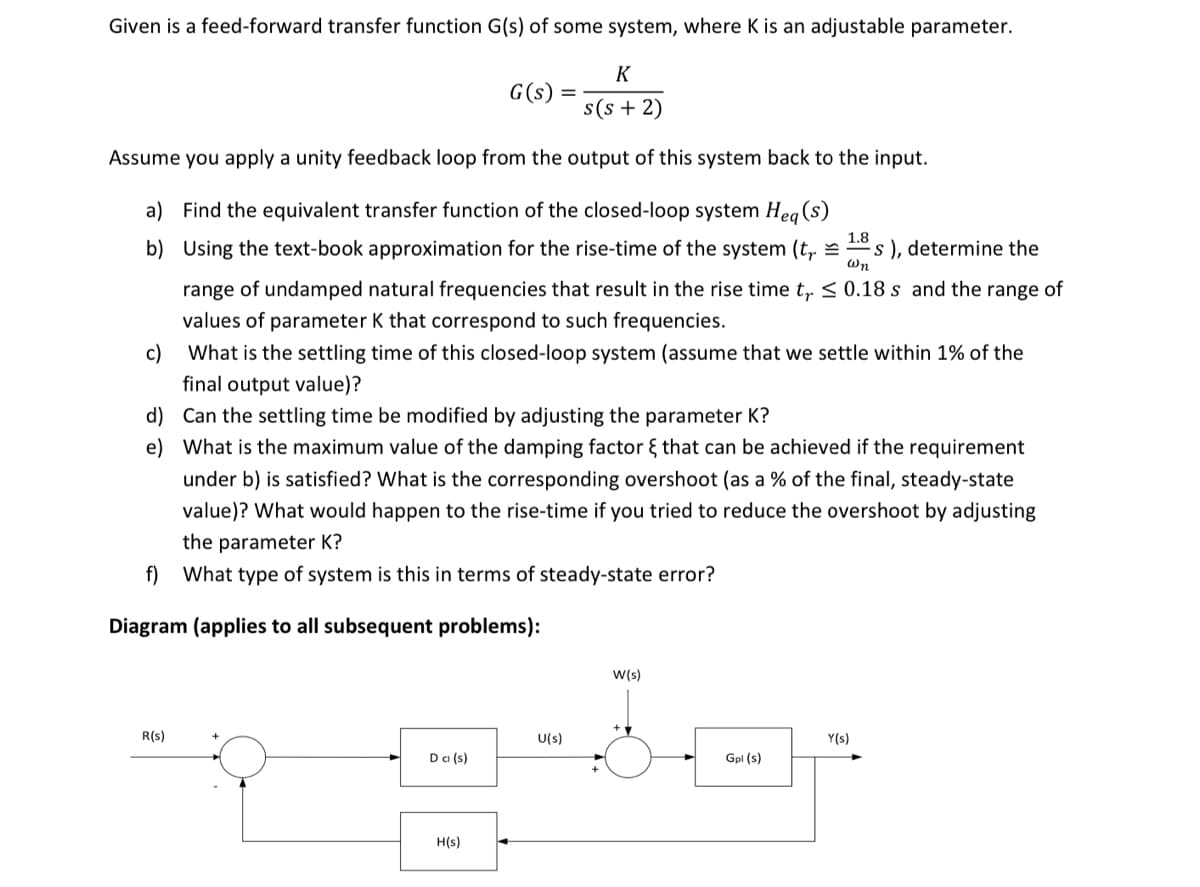Given is a feed-forward transfer function G(s) of some system, where K is an adjustable parameter. K G(s) s(s + 2) Assume you apply a unity feedback loop from the output of this system back to the input. a) Find the equivalent transfer function of the closed-loop system Heg (s) b) Using the text-book approximation for the rise-time of the system (t, = 1.8 s ), determine the Wn range of undamped natural frequencies that result in the rise time t, < 0.18 s and the range of values of parameter K that correspond to such frequencies. c) What is the settling time of this closed-loop system (assume that we settle within 1% of the final output value)? d) Can the settling time be modified by adjusting the parameter K? e) What is the maximum value of the damping factor { that can be achieved if the requirement under b) is satisfied? What is the corresponding overshoot (as a % of the final, steady-state value)? What would happen to the rise-time if you tried to reduce the overshoot by adjusting the parameter K? f) What type of system is this in terms of steady-state error? Diagram (applies to all subsequent problems): w(s) R(s) U(s) Y(s) Da (s) Gpl (s) H(s)
Given is a feed-forward transfer function G(s) of some system, where K is an adjustable parameter. K G(s) s(s + 2) Assume you apply a unity feedback loop from the output of this system back to the input. a) Find the equivalent transfer function of the closed-loop system Heg (s) b) Using the text-book approximation for the rise-time of the system (t, = 1.8 s ), determine the Wn range of undamped natural frequencies that result in the rise time t, < 0.18 s and the range of values of parameter K that correspond to such frequencies. c) What is the settling time of this closed-loop system (assume that we settle within 1% of the final output value)? d) Can the settling time be modified by adjusting the parameter K? e) What is the maximum value of the damping factor { that can be achieved if the requirement under b) is satisfied? What is the corresponding overshoot (as a % of the final, steady-state value)? What would happen to the rise-time if you tried to reduce the overshoot by adjusting the parameter K? f) What type of system is this in terms of steady-state error? Diagram (applies to all subsequent problems): w(s) R(s) U(s) Y(s) Da (s) Gpl (s) H(s)
Introductory Circuit Analysis (13th Edition)
13th Edition
ISBN:9780133923605
Author:Robert L. Boylestad
Publisher:Robert L. Boylestad
Chapter1: Introduction
Section: Chapter Questions
Problem 1P: Visit your local library (at school or home) and describe the extent to which it provides literature...
Related questions
Question

Transcribed Image Text:Given is a feed-forward transfer function G(s) of some system, where K is an adjustable parameter.
K
G(s)
s(s + 2)
Assume you apply a unity feedback loop from the output of this system back to the input.
a) Find the equivalent transfer function of the closed-loop system Heg (s)
b) Using the text-book approximation for the rise-time of the system (t, =
1.8
s ), determine the
Wn
range of undamped natural frequencies that result in the rise time t, < 0.18 s and the range of
values of parameter K that correspond to such frequencies.
c)
What is the settling time of this closed-loop system (assume that we settle within 1% of the
final output value)?
d) Can the settling time be modified by adjusting the parameter K?
e) What is the maximum value of the damping factor { that can be achieved if the requirement
under b) is satisfied? What is the corresponding overshoot (as a % of the final, steady-state
value)? What would happen to the rise-time if you tried to reduce the overshoot by adjusting
the parameter K?
f) What type of system is this in terms of steady-state error?
Diagram (applies to all subsequent problems):
w(s)
R(s)
U(s)
Y(s)
Dci (s)
Gpl (s)
H(s)
Expert Solution
This question has been solved!
Explore an expertly crafted, step-by-step solution for a thorough understanding of key concepts.
This is a popular solution!
Trending now
This is a popular solution!
Step by step
Solved in 2 steps with 2 images

Knowledge Booster
Learn more about
Need a deep-dive on the concept behind this application? Look no further. Learn more about this topic, electrical-engineering and related others by exploring similar questions and additional content below.Recommended textbooks for you

Introductory Circuit Analysis (13th Edition)
Electrical Engineering
ISBN:
9780133923605
Author:
Robert L. Boylestad
Publisher:
PEARSON

Delmar's Standard Textbook Of Electricity
Electrical Engineering
ISBN:
9781337900348
Author:
Stephen L. Herman
Publisher:
Cengage Learning

Programmable Logic Controllers
Electrical Engineering
ISBN:
9780073373843
Author:
Frank D. Petruzella
Publisher:
McGraw-Hill Education

Introductory Circuit Analysis (13th Edition)
Electrical Engineering
ISBN:
9780133923605
Author:
Robert L. Boylestad
Publisher:
PEARSON

Delmar's Standard Textbook Of Electricity
Electrical Engineering
ISBN:
9781337900348
Author:
Stephen L. Herman
Publisher:
Cengage Learning

Programmable Logic Controllers
Electrical Engineering
ISBN:
9780073373843
Author:
Frank D. Petruzella
Publisher:
McGraw-Hill Education

Fundamentals of Electric Circuits
Electrical Engineering
ISBN:
9780078028229
Author:
Charles K Alexander, Matthew Sadiku
Publisher:
McGraw-Hill Education

Electric Circuits. (11th Edition)
Electrical Engineering
ISBN:
9780134746968
Author:
James W. Nilsson, Susan Riedel
Publisher:
PEARSON

Engineering Electromagnetics
Electrical Engineering
ISBN:
9780078028151
Author:
Hayt, William H. (william Hart), Jr, BUCK, John A.
Publisher:
Mcgraw-hill Education,